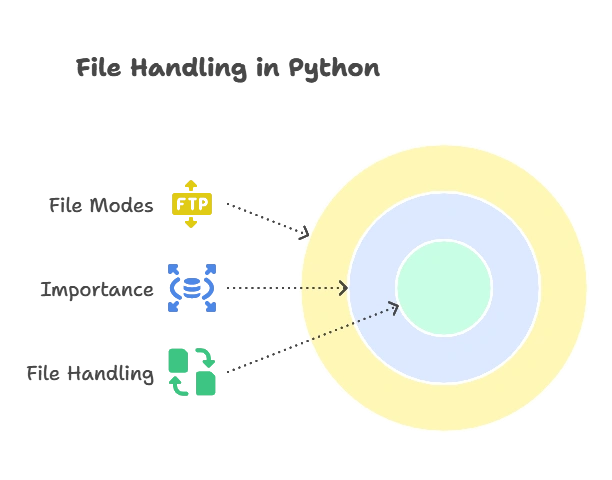File Methods in Python
File handling is an essential aspect of programming, allowing us to read from and write to files on disk. In this topic, we'll explore various file methods that enable us to perform operations such as opening, reading, writing, and closing files efficiently. From basic operations like open() and read() to more advanced techniques for file manipulation and error handling.
Understanding File Handling in Python
In this section, we’ll cover the basics of file handling in Python and understand its significance in programming.
What is File Handling?
File handling in Python involves performing operations on files, such as reading data from files, writing data to files, and manipulating file contents.
Why File Handling is Important?
File handling is crucial for interacting with external data sources, storing data persistently, and performing various data processing tasks in Python applications.
File Modes
File modes specify the purpose of opening a file, such as reading, writing, or appending. Common file modes include 'r' for reading, 'w' for writing, and 'a' for appending.

Basic File Methods
In this section, we’ll explore some of the most commonly used basic file methods in Python.
open() Function
The open() function is used to open a file and returns a file object that can be used to perform various file operations.
file = open('example.txt', 'r')
Explanation:
- The
open('example.txt', 'r')function opens the file named'example.txt'in read mode ('r') and returns a file objectfile.
read() Method
The read() method reads the contents of the entire file and returns it as a string.
content = file.read()
print(content)
Explanation:
- The
read()method reads the contents of the file objectfileand stores it in the variablecontent, which is then printed.
Advanced File Methods
In this section, we’ll explore advanced file methods that offer powerful functionalities for file manipulation, error handling, and context management.
write() Method
The write() method is used to write data to a file. It takes a string as an argument and writes it to the file.
with open('example.txt', 'w') as file:
file.write('Hello, world!\n')
file.write('This is a test file.\n')
Explanation:
- The
write()method is used to write the strings'Hello, world!'and'This is a test file.'to the file named'example.txt'.
close() Method
The close() method is used to close the file object, releasing system resources associated with it.
file = open('example.txt', 'r')
content = file.read()
file.close()
Explanation:
- The
close()method is called on the file objectfileto close the file after reading its contents.
with Statement
The with statement is used to automatically manage the opening and closing of files, ensuring that resources are properly released.
with open('example.txt', 'r') as file:
content = file.read()
Explanation:
- The
withstatement automatically closes the file objectfileafter the block of code inside it is executed.
File Navigation and Handling Directories
In this section, we’ll explore file navigation methods and techniques for handling directories in Python.
File Navigation Methods
Python provides several methods for navigating files and directories, including os.getcwd() to get the current working directory and os.chdir() to change the current working directory.
import os
# Get the current working directory
current_directory = os.getcwd()
print("Current directory:", current_directory)
# Change the current working directory
os.chdir('/path/to/new/directory')
print("New directory:", os.getcwd())
Explanation:
- The
os.getcwd()function returns the current working directory. - The
os.chdir()function is used to change the current working directory to the specified path.
Handling Directories
Python’s os module provides various methods for handling directories, such as creating directories with os.mkdir(), removing directories with os.rmdir(), and checking if a directory exists with os.path.exists().
import os
# Create a new directory
os.mkdir('new_directory')
# Remove a directory
os.rmdir('new_directory')
# Check if a directory exists
if os.path.exists('new_directory'):
print("Directory exists")
else:
print("Directory does not exist")
Explanation:
- The
os.mkdir()function creates a new directory with the specified name. - The
os.rmdir()function removes the specified directory. - The
os.path.exists()function checks if the specified directory exists.
We've covered a wide range of file methods in Python, from basic file operations like opening, reading, and writing to more advanced techniques for file navigation and directory handling. File handling is a fundamental aspect of programming, allowing us to interact with external data sources, store data persistently, and perform various data processing tasks.
By mastering these file methods, you gain the ability to efficiently read from and write to files, navigate directories, and handle file-related tasks in your Python applications. Whether you're working with text files, binary files, or directories, Python provides powerful tools and libraries to streamline your file handling tasks. Happy Coding!❤️
